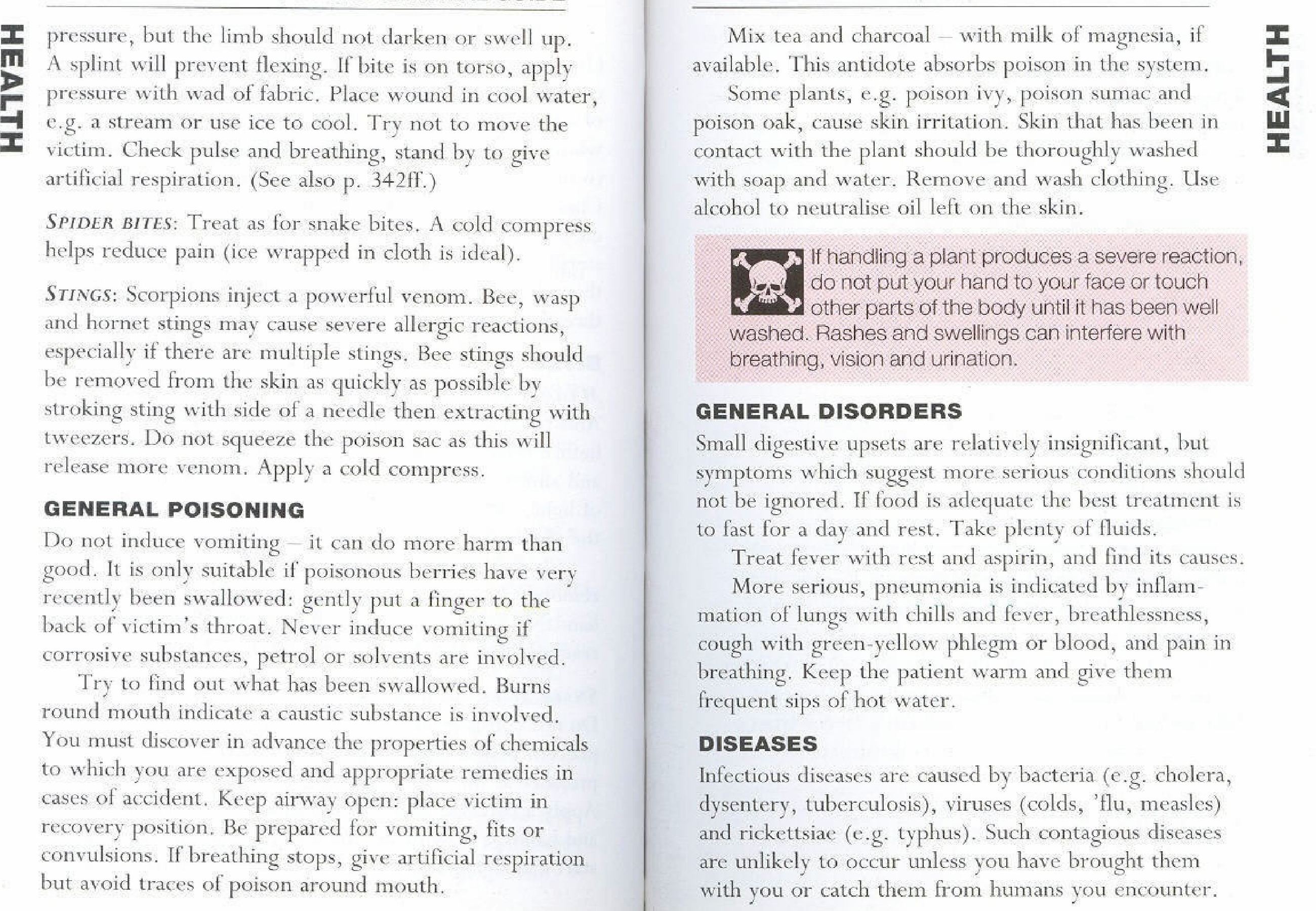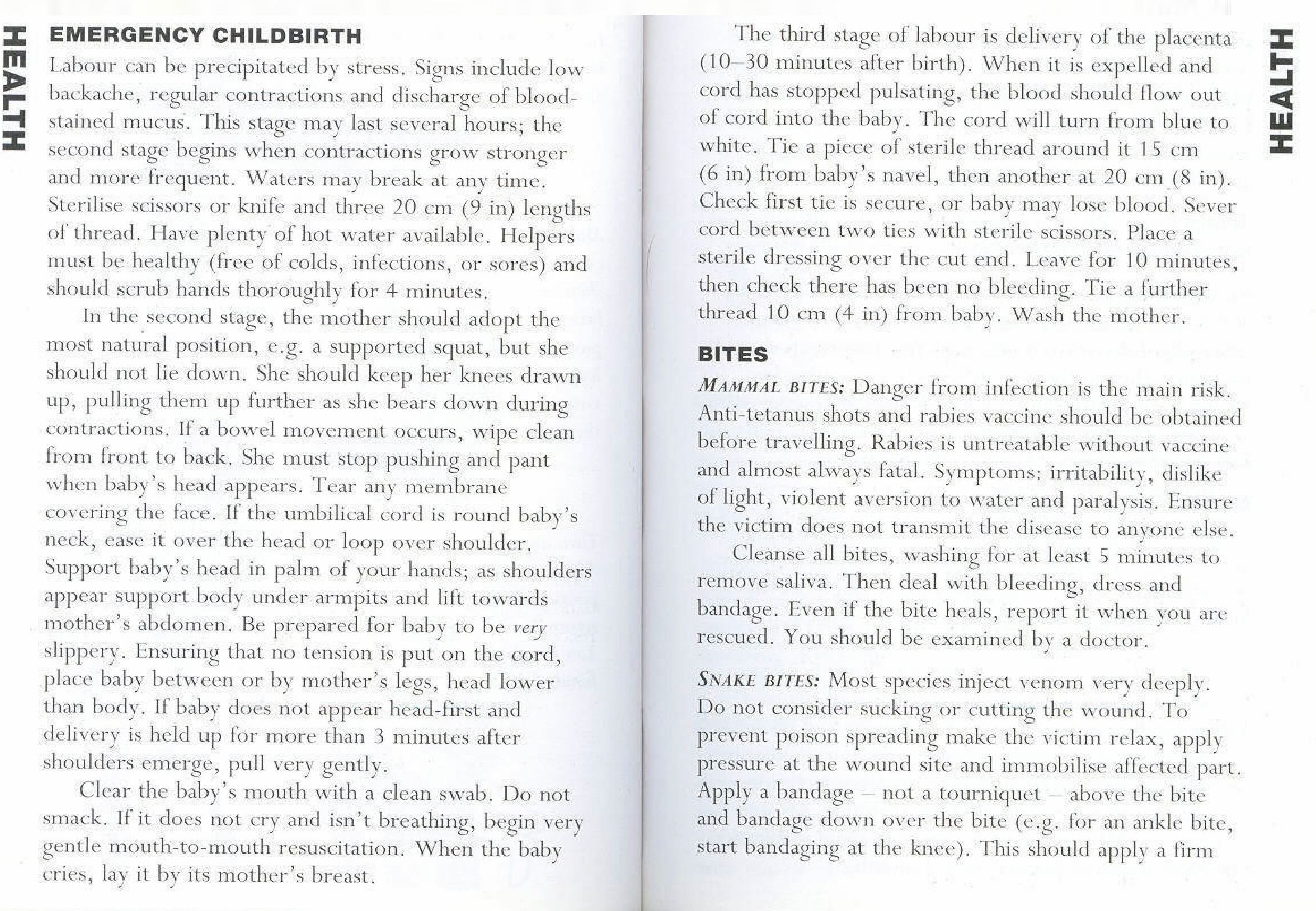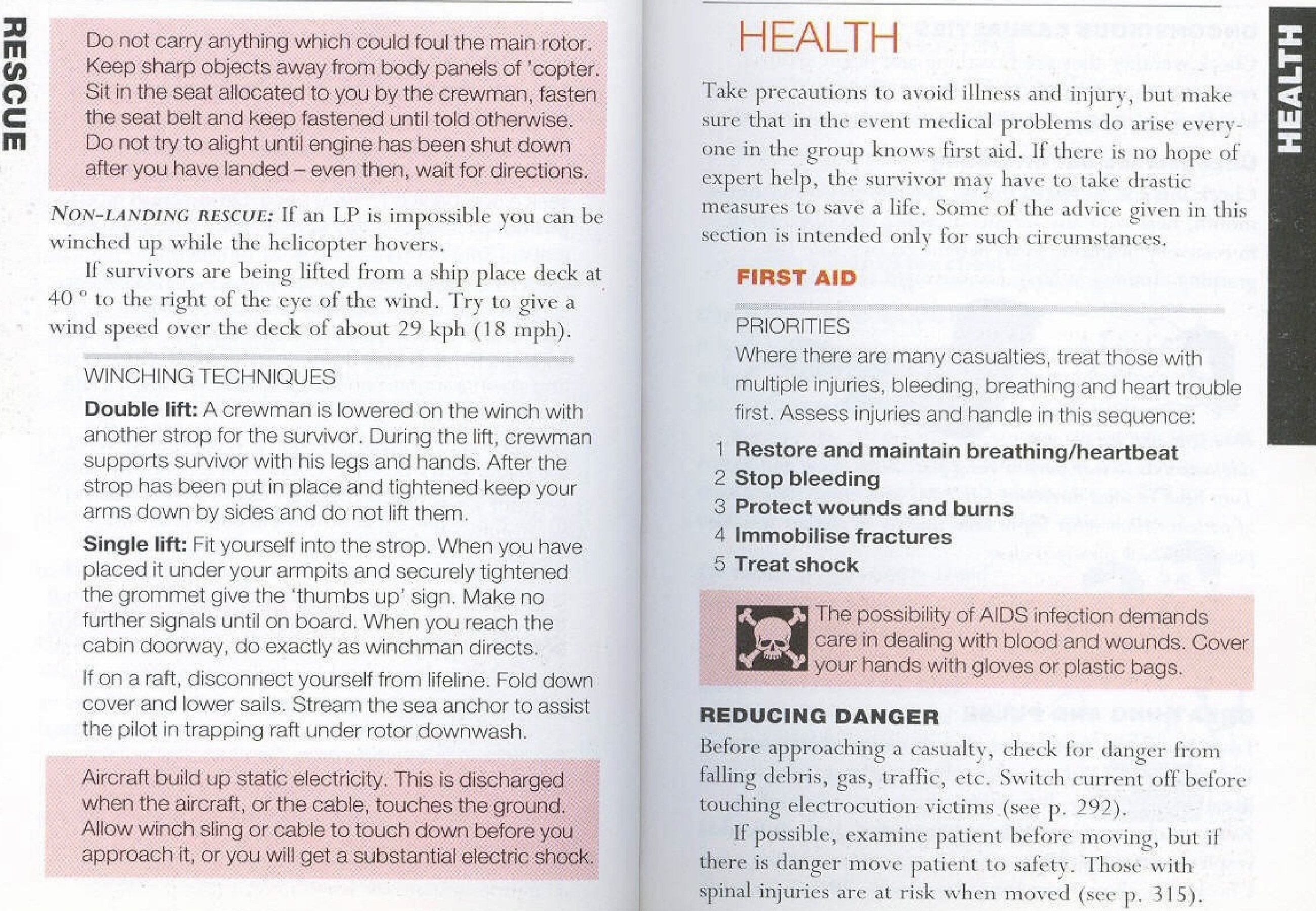Upload Your Infographic
 InfoHow.org
InfoHow.org
Categories
- Advice
- Animals
- Architecture
- Arts
- Banking
- Bitcoin & Blockchain
- Business, Finance & Employment
- Companies
- Countries, Maps & Geography
- Education
- Electronics & Technology
- Entertainment
- Fashion, Clothing & Grooming
- Food & Drink
- Holidays
- How To
- Internet & Communication
- Law & Crime
- Popular Culture & Social Media
- Science
- Social Science
- Society, Culture & Relationships
- Sports & Health
- Statistics
- Survival DIY
- War, Weapons & Military
Survival DIY Archive
SAS 156 – Diseases
To reduce risk keep skin covered, sleep under a mosquito net, use insect repellents, and do not camp near swamps or stagnat water. A course of tablets, begun before exposure, […]
SAS 155 – Diseases
When in water, the survivor is more likely to be exposed to water – borne diseases, or those carried by insects and animals. Tropical diseases are less familiar and will […]
SAS 153 – First Aid, Emergency Childbirth & Bites
Dangers from infection is the main risk. Anti-tetanus shots and rabies vaccine should be obtained before travelling. Rabies is untreatable without vaccine and almost always fatal.
SAS 152 – First Aid & Moving the Injured
During the conscious casuality of the victim, Grasp victim’s right wrist. Bend your head under his arm so your shoulder is level with his lower abdomen. Bend your knees, allowing […]
SAS 148 – First Aid & Fractures
The types of fractures that may effect are Fracture of the Hip or Upper Leg, Fracture of the knee, Fracture of the lower leg, Fracture of the Ankle or foot, […]
SAS 146 – First Aid, Burns & Fractures
Types of burns: Deep burns are charred or white, and bone or muscle may be visible. Superficial burns are much more painful. Blisters should never be burst deliverately. If face […]
SAS 145 – First Aid & Wounds
Soap is an antiseptic: use to wash wounds. Wash hands in boiled water before cleaning wound. Wash wound in boiled water or if none is available use urine, which is […]
SAS 144 – First Aid & Wounds
Lesser the bleeding immediately. Clean the wound carefully and apply a sterile dressing during an injury. To avoid the risk of infection, do not touch the wound or allow non-sterile […]
SAS 143 – First Aid, CPR & Bleeding
Arterial bleeding: Speed is vital in stopping blood spurting from an artery. Compress the artery at pressure points where it runs ear the surface over a bone. Watch the wound: […]
SAS 141 – First Aid & Choking
Holger Nielson Method of Respiration: Use to resuscitate a drowning victim if mouth to mouth not possible. Face-down position allows liquids to flow freely from mouth without choking the patient. […]
SAS 140 – First Aid & Mouth to Mouth
Artificial Respiration: With any form of resucitation the first five minutes are the most critical, but if breathing does not start, keep artificial respiration up for at least an hour. […]
SAS 139 – First Aid & Choking
To prevent Asphyxiation, Pressure on chest can cause asphyxiation. In an avalanche or landslide, crouch with arms bent and elbows tucked well in to protect the chest. A climber who […]
SAS 138 – First Aid & Choking
Heimlich Manqeuvre: Stand behind a cognizant setback, arms around them. Make a clench hand of one hand and press it thumb inwards above navel but beneath breastbone. Catch different hand […]
SAS 137 – Rescue & First Aid
Before approaching a casuality, check for danger from falling debris, gas traffic, etc. Switch current off before touching electrocution victims.
SAS 136 – Rescue & Signalling
Helicopter Rescue: Helicopters are frequently used to carry out rescues. Where possible the pilot will land to take on survivors and fly them out. Survivors should check out suitable landing […]
SAS 135 – Rescue & Signalling
Information Signals: If you abandon camp leave clear direction markers to indicate your route. Continue to make them, not only for people to follow but to establish your own route […]
SAS 133 – Rescue & Signalling
Rag Signals: Tie a flag or a piece of bright – coloured clothing to a pole. Move it left for dashes and right for dots. Exaggerate with a figure of […]
SAS 132 – Rescue & Signalling
Heliograph: Use the sun and a reflector to flash light signals. Any shiny object will do – polished tin, glass, a piece of foil – but a hand mirror is […]
SAS 131 – Rescue & Signalling
By day smoke is good locator. Have a supply of smoke-producing material ready to put on your fires. Smoke not only helps rescue aircraft find you, it also shows surface […]
SAS 130 – Rescue & Signalling
Siting the signals: Take account of the terrain. Choose high points for light signals. Erect an unusual silhouette or a ridge to attract attention. Planes fly over hilly territory from […]
SAS 128 – Sea Survival & Fishing
The survival at sea is vulnerable to shark attack. Ocean sharks are not usually ferocious when food is plentiful. Most are cowards and can be scared off by the jab […]
SAS 127 – Sea Survival, Water Rationing & Fishing
Conserve emergency food supplies until needed. Try to live off sea life. There are dangerous fish, but in the open sea, fish are generally safe to eat. Near the shore […]
SAS 125 – Sea Survival & Signalling
How to Signal at Sea ? Use flares, dye markers and movement of any kind to attract attention at sea. If you have no signalling equipment, wave clothing or tarpauliins […]

![SAS 156 – Diseases To reduce risk keep skin covered, sleep under a mosquito net, use insect repellents, and do not camp near swamps or stagnat water. A course of tablets, begun before exposure, […]](https://www.infohow.org/wp-content/uploads/2012/11/SAS-156-Diseases.jpg)
![SAS 155 – Diseases When in water, the survivor is more likely to be exposed to water – borne diseases, or those carried by insects and animals. Tropical diseases are less familiar and will […]](https://www.infohow.org/wp-content/uploads/2012/11/SAS-155-Diseases.jpg)


![SAS 152 – First Aid & Moving the Injured During the conscious casuality of the victim, Grasp victim’s right wrist. Bend your head under his arm so your shoulder is level with his lower abdomen. Bend your knees, allowing […]](https://www.infohow.org/wp-content/uploads/2012/11/SAS-152-First-Aid-Moving-the-Injured.jpg)
![SAS 148 – First Aid & Fractures The types of fractures that may effect are Fracture of the Hip or Upper Leg, Fracture of the knee, Fracture of the lower leg, Fracture of the Ankle or foot, […]](https://www.infohow.org/wp-content/uploads/2012/11/SAS-148-First-Aid-Fractures.jpg)
![SAS 146 – First Aid, Burns & Fractures Types of burns: Deep burns are charred or white, and bone or muscle may be visible. Superficial burns are much more painful. Blisters should never be burst deliverately. If face […]](https://www.infohow.org/wp-content/uploads/2012/11/SAS-146-First-Aid-Burns-Fractures.jpg)
![SAS 145 – First Aid & Wounds Soap is an antiseptic: use to wash wounds. Wash hands in boiled water before cleaning wound. Wash wound in boiled water or if none is available use urine, which is […]](https://www.infohow.org/wp-content/uploads/2012/11/SAS-145-First-Aid-Wounds.jpg)
![SAS 144 – First Aid & Wounds Lesser the bleeding immediately. Clean the wound carefully and apply a sterile dressing during an injury. To avoid the risk of infection, do not touch the wound or allow non-sterile […]](https://www.infohow.org/wp-content/uploads/2012/11/SAS-144-First-Aid-Wounds.jpg)
![SAS 143 – First Aid, CPR & Bleeding Arterial bleeding: Speed is vital in stopping blood spurting from an artery. Compress the artery at pressure points where it runs ear the surface over a bone. Watch the wound: […]](https://www.infohow.org/wp-content/uploads/2012/11/SAS-143-First-Aid-CPR-Bleeding.jpg)
![SAS 141 – First Aid & Choking Holger Nielson Method of Respiration: Use to resuscitate a drowning victim if mouth to mouth not possible. Face-down position allows liquids to flow freely from mouth without choking the patient. […]](https://www.infohow.org/wp-content/uploads/2012/11/SAS-141-First-Aid-Choking.jpg)
![SAS 140 – First Aid & Mouth to Mouth Artificial Respiration: With any form of resucitation the first five minutes are the most critical, but if breathing does not start, keep artificial respiration up for at least an hour. […]](https://www.infohow.org/wp-content/uploads/2012/11/SAS-140-First-Aid-Mouth-to-Mouth1.jpg)
![SAS 139 – First Aid & Choking To prevent Asphyxiation, Pressure on chest can cause asphyxiation. In an avalanche or landslide, crouch with arms bent and elbows tucked well in to protect the chest. A climber who […]](https://www.infohow.org/wp-content/uploads/2012/11/SAS-139-First-Aid-Choking.jpg)
![SAS 138 – First Aid & Choking Heimlich Manqeuvre: Stand behind a cognizant setback, arms around them. Make a clench hand of one hand and press it thumb inwards above navel but beneath breastbone. Catch different hand […]](https://www.infohow.org/wp-content/uploads/2012/11/SAS-138-First-Aid-Choking.jpg)

![SAS 136 – Rescue & Signalling Helicopter Rescue: Helicopters are frequently used to carry out rescues. Where possible the pilot will land to take on survivors and fly them out. Survivors should check out suitable landing […]](https://www.infohow.org/wp-content/uploads/2012/11/SAS-136-Rescue-Signalling.jpg)
![SAS 135 – Rescue & Signalling Information Signals: If you abandon camp leave clear direction markers to indicate your route. Continue to make them, not only for people to follow but to establish your own route […]](https://www.infohow.org/wp-content/uploads/2012/11/SAS-135-Rescue-Signalling.jpg)
![SAS 133 – Rescue & Signalling Rag Signals: Tie a flag or a piece of bright – coloured clothing to a pole. Move it left for dashes and right for dots. Exaggerate with a figure of […]](https://www.infohow.org/wp-content/uploads/2012/11/SAS-133-Rescue-Signalling.jpg)
![SAS 132 – Rescue & Signalling Heliograph: Use the sun and a reflector to flash light signals. Any shiny object will do – polished tin, glass, a piece of foil – but a hand mirror is […]](https://www.infohow.org/wp-content/uploads/2012/11/SAS-132-Rescue-Signalling.jpg)
![SAS 131 – Rescue & Signalling By day smoke is good locator. Have a supply of smoke-producing material ready to put on your fires. Smoke not only helps rescue aircraft find you, it also shows surface […]](https://www.infohow.org/wp-content/uploads/2012/11/SAS-131-Rescue-Signalling.jpg)
![SAS 130 – Rescue & Signalling Siting the signals: Take account of the terrain. Choose high points for light signals. Erect an unusual silhouette or a ridge to attract attention. Planes fly over hilly territory from […]](https://www.infohow.org/wp-content/uploads/2012/11/SAS-130-Rescue-Signalling.jpg)
![SAS 128 – Sea Survival & Fishing The survival at sea is vulnerable to shark attack. Ocean sharks are not usually ferocious when food is plentiful. Most are cowards and can be scared off by the jab […]](https://www.infohow.org/wp-content/uploads/2012/11/SAS-128-Sea-Survival-Fishing.jpg)
![SAS 127 – Sea Survival, Water Rationing & Fishing Conserve emergency food supplies until needed. Try to live off sea life. There are dangerous fish, but in the open sea, fish are generally safe to eat. Near the shore […]](https://www.infohow.org/wp-content/uploads/2012/11/SAS-127-Sea-Survival-Water-Rationing-Fishing.jpg)
![SAS 125 – Sea Survival & Signalling How to Signal at Sea ? Use flares, dye markers and movement of any kind to attract attention at sea. If you have no signalling equipment, wave clothing or tarpauliins […]](https://www.infohow.org/wp-content/uploads/2012/11/SAS-125-Sea-Survival-Signalling.jpg)
 Upload your infographic here and contribute to our community.
Upload your infographic here and contribute to our community.